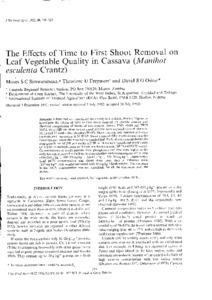| dc.contributor.author | Simwambana, M. |
| dc.contributor.author | Ferguson, T. |
| dc.contributor.author | Osiru, D. |
| dc.date.accessioned | 2019-12-04T11:27:51Z |
| dc.date.available | 2019-12-04T11:27:51Z |
| dc.date.issued | 1992 |
| dc.identifier.citation | Simwambana, M., Ferguson, T. & Osiru, D. (1992). The effects of time to first shoot removal on leaf vegetable quality in cassava ( Manihot esculenta Crantz). Journal of the Science of Food and Agriculture, 60(3), 319-325. |
| dc.identifier.issn | 0022-5142 |
| dc.identifier.uri | https://hdl.handle.net/20.500.12478/5026 |
| dc.description.abstract | A field trial was established on a sandy soil at IITA. Ibadan. Nigeria to investigate the effects of time to first shoot removal on cyanide content and chemical composition of leaves of two cassava clones: TMS 91934 and TMS 30572. Four different times to first shoot removal were imposed on each clone: 8. 14, 20 and 52 weeks after planting (WAP). Shoot removal was repeated at 8‐week intervals until harvesting at 52 WAP. Shoot removal (SR) involved removing the shoot tips just below the most fully expanded leaf. Early shoot removal during the crop growth period (SR at 8 weeks and SR at 14 weeks 14) produced significantly (P < 0.01) more fresh shoot yield than late shoot removal (SR20 and SR52 weeks). Concentrations of crude protein, iron, phosphorus and zinc were higher in the early harvested leaves but declined in concentration with increasing age of the crop (430–280 g kg−1, 680–85 mg kg−1, 88–42 g kg−1, 128–30 mg kg−1, respectively). Leaf HCN concentration was about three times that in tuberous roots (137 mg kg−1 fresh weight compared with 43 mg kg−1 fresh weight). The variation in leaf HCN concentration was not significant for all the treatments over the period. |
| dc.language.iso | en |
| dc.subject | Cassava |
| dc.subject | Leaf Vegetables |
| dc.subject | Nutritive Value |
| dc.subject | Consumption |
| dc.title | The effects of time to first shoot removal on leaf vegetable quality in cassava ( Manihot esculenta Crantz) |
| dc.type | Journal Article |
| dc.description.version | Peer Review |
| cg.contributor.affiliation | Lua pula Regional station, Zambia |
| cg.contributor.affiliation | University of the West Indies |
| cg.contributor.affiliation | International Institute of Tropical Agriculture |
| cg.coverage.region | Africa |
| cg.coverage.region | Acp |
| cg.coverage.region | East Africa |
| cg.coverage.region | Caribbean |
| cg.coverage.region | West Africa |
| cg.coverage.country | Zambia |
| cg.coverage.country | Trinidad And Tobago |
| cg.coverage.country | Nigeria |
| cg.isijournal | ISI Journal |
| cg.authorship.types | CGIAR and developing country institute |
| cg.iitasubject | Nutrition |
| cg.iitasubject | Food Security |
| cg.iitasubject | Livelihoods |
| cg.iitasubject | Cassava |
| cg.iitasubject | Plant Production |
| cg.accessibilitystatus | Limited Access |
| local.dspaceid | 102289 |
| cg.identifier.doi | https://doi.org/10.1002/jsfa.2740600308 |

